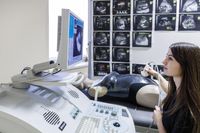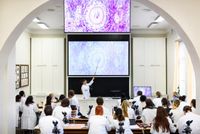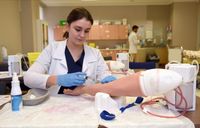Studying human medicine in Riga
Structure of studies: First things first...
In its English-language medicine programme, the RSU places a strong emphasis on small groups, practical relevance, anatomy training with a traditional dissection course, but also makes extensive use of simulation technology during the course.
Amount of study places
Approximately 600 international medical students begin their studies at RSU Riga each academic year. It is possible to start your studies in both September and February of each year. In autumn, the start is significantly larger with almost 350 students than in winter, when almost 250 prospective doctors begin. In total, there are more than 2,500 international full-time students on campus.
Preclinical and clinical part of studies
The first four semesters of the course are spent here, comparable to German universities, as the pre-clinical part of the programme. The main subjects taught are the natural sciences, such as biology, chemistry and physics, as well as extensive anatomy with its own dissection course. This is followed by a further eight semesters, the clinical part of the training, which takes place at the cooperating university hospitals.
The course itself relies heavily on learning in small, class-like groups, known as study groups. From the first semester onwards, about 12-15 students come together in these study groups to work through the basic theoretical subjects. Exams, tests and verifications take place throughout the semester, at intervals of one to two weeks. This ensures that not all study work has to be completed at the end of the semester and that the number of exams is spread over the semester.
Classical dissection course
Another important part of the programme is the integration of the Medical Education Technology Centre (METC). This is a very large simulation lab where treatment situations are simulated in specially equipped technology rooms and on high-tech dummies. The METC is housed in its own building, comparable to a small hospital and about 15 minutes from the RSU Riga campus. It is used by both medical students and doctors for further training.
Nevertheless, the classical anatomy training, which takes place in the form of dissection courses in the Anatomical Institute with its affiliated Anatomical Museum, remains extremely important. Although 3D simulators are also used in anatomy courses to help students understand the structure and functions of the human body, the focus for learning macroscopic anatomy remains on the classical form of teaching.
Scope of studies
The standard period of study for human medicine in Latvia is twelve semesters. During this time, a total of 360 ECTS credits are earned. In semesters 5-12, there are extensive internships and clinical traineeships, which can be completed in Latvia or in other countries.
Upon graduation, German graduates receive the international title of ‘Medical Doctor’. With this, you can apply for a licence to practice medicine in your home country within the EU and start working as a doctor in training at a German clinic immediately after graduation. Many German graduates already work in Germany. The reputation of the RSU Riga is extremely high far beyond the borders of Latvia.
Many Germans also study dentistry at RSU in Latvia in English. This programme is designed to take ten semesters. Detailed information on the application and admission process at RSU can be found here on our website.


